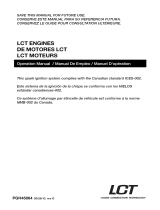
4 SE c T i O N 2 — iM P O R T A N T EN g i N E SA f E OP E R A T i O N PR A c T i c E S
Do not overfill fuel tank. Fill tank to full as indicated by the 7.
fuel level indicator installed inside of the fuel tank. Do not
over-fill to allow space for fuel expansion. On some models,
a fuel level indicator may NOT be present, in this instance,
fill the tank no more than 1/2 inch below the bottom of the
filler neck to allow space for fuel expansion.
Replace fuel cap and tighten until the cap ratchets.8.
If gasoline is spilled, wipe it off the engine and the 9.
equipment. Move the machine to another area. Wait five
minutes before starting the engine.
To reduce fire hazards, keep the machine free of grass , 10.
leaves or other debris build up. Clean up oil or fuel spillage
and remove any fuel-soaked debris.
Keep gasoline away from sparks, open flames, pilot lights, 11.
heat, and other ignition sources.
Never fuel equipment indoors because flammable vapors 12.
will accumulate in the area.
Extinguish all cigarettes, cigars, pipes, and other sources of 13.
ignition.
Check fuel line, tank, cap, and fittings frequently for cracks 14.
or leaks. Replace if necessary.
Operation
When starting the engine, make sure spark plug, muffler, 1.
and fuel cap are in place.
Do not crank engine with spark plug removed.2.
If fuel spills, wait until it evaporates before starting engine.3.
Allow muffler, engine cylinder, and fins to cool before 4.
touching.
Keep children away from hot or running engines. They can 5.
suffer burns from a hot muffler.
Remove accumulated combustibles from muffler and 6.
cylinder area.
Operate equipment with all guards in place.7.
Keep hands and feet away from rotating parts.8.
Tie up long hair and remove jewelry.9.
Do not wear loose-fitting clothing, dangling drawstrings or 10.
items that could become caught.
When starting the engine, pull cord slowly until resistance 11.
is felt, then pull rapidly.
Remove all external equipment/engine loads before 12.
starting engine.
Direct coupled equipment components such as, but not 13.
limited to blades, impellers, pulleys, sprockets, etc., must
be securely attached.
Maintenance & Storage
Keep the engine in safe working order1.
Allow the engine to cool at least five minutes before 2.
storing. Never tamper with safety devices. Check their
proper operation regularly.
Check bolts and screws for proper tightness at frequent 3.
intervals to keep the engine in safe working condition.
Visually inspect the engine for any damage.
Before cleaning, repairing or inspecting; stop the 4.
engine and make certain all moving parts have stopped.
Disconnect the spark plug wire and ground it against the
engine to prevent unintended starting.
Do not change the engine governor settings or over-speed 5.
the engine. The governor controls the maximum safe
operating speed of the engine.
Maintain and replace safety and instruction labels as 6.
necessary.
Always refer to the operator’s manual for important details 7.
if the machine is to be stored for an extended period of
time.
If the fuel tank has to be drained, do this outdoors.8.
Observe proper disposal laws and regulations for gas, oil, 9.
etc. to protect the environment.
Do not modify engine
To avoid serious injury or death, do not modify engine in any
way. Tampering with the governor setting can lead to a runaway
engine and cause it to operate at unsafe speeds. Never tamper
with factory setting of engine governor.
Notice Regarding Emissions
Engines which are certified to comply with California and federal
EPA emission regulations for SORE (Small Off Road Equipment)
are certified to operate on regular unleaded gasoline, and
may include the following emission control systems: Engine
Modification (EM), Oxidizing Catalyst (OC), Secondary Air
Injection (SAI) and Three Way Catalyst (TWC) if so equipped.
Spark Arrestor
WARNING: This machine is equipped with an
internal combustion engine and should not be used
on or near any unimproved forest-covered, brush
covered or grass-covered land unless the engine’s
exhaust system is equipped with a spark arrester
meeting applicable local or state laws (if any).
If a spark arrester is used, it should be maintained in effective
working order by the operator.
A spark arrester for the muffler is available through your nearest
engine authorized service dealer.




















